(projects)
(filter by: )
reset filter



Walking as an Instrument
2024
Aqtushetii, Omalo, Tusheti, GE
(work in progress, 2024-now)
Aqtushetii, Omalo, Tusheti, GE
supported by Mondriaan Fonds
During my residency at Aqtushetii (2024) I've focused on the cultural phenomenon of ‘transhumance’: the seasonal movement of sheep between higher and lower sites. Because of the remote and isolated character of Tusheti, I was interested in how these migrations have the ability to give insights into local traditions and ancient rituals manifested into different mediums — thereby highlighting the interdependence between (human/non-human) communities and the landscapes they inhabit.
The knowledge and lore of the tradition are, as it were, almost only captivated in the sounds shepherds make, the echoes they create through the landscape, and the tracks itself. Following both traditional pastoral paths and recent ones every day for a month on foot, the research resulted in a collection of walks: using them as a means to archive my individual memories and connect them to a collective one. Walking became my research method to perform a trace together and exchange the events that unfolded along it beyond the use of language.
This (sound) work is currently in progress.
Aqtushetii, Omalo, Tusheti, GE
supported by Mondriaan Fonds
During my residency at Aqtushetii (2024) I've focused on the cultural phenomenon of ‘transhumance’: the seasonal movement of sheep between higher and lower sites. Because of the remote and isolated character of Tusheti, I was interested in how these migrations have the ability to give insights into local traditions and ancient rituals manifested into different mediums — thereby highlighting the interdependence between (human/non-human) communities and the landscapes they inhabit.
The knowledge and lore of the tradition are, as it were, almost only captivated in the sounds shepherds make, the echoes they create through the landscape, and the tracks itself. Following both traditional pastoral paths and recent ones every day for a month on foot, the research resulted in a collection of walks: using them as a means to archive my individual memories and connect them to a collective one. Walking became my research method to perform a trace together and exchange the events that unfolded along it beyond the use of language.
This (sound) work is currently in progress.




Ceremony: August In The Water
2024
Gibraltarstraat 74, Amsterdam, NL
Ceremony: August in the Water, 2024
Gibraltarstraat 74B and Pierenbadje Gibraltar, Amsterdam, NL
collective screening, ephemera, drinks, sound ritual
Ceremony (place, date, time) is a platform formed by Pam Virada, Natasha Linde Krebs, and Ilya Lindhout, facilitating shared spaces for collective imagination and reimagination in cinema. We explore how we can experience togetherness in the presence of the moving image by questioning the fundamentals of cinema: how do we sit? Where should the cinema be? How do we arrive to the cinema? We host displaced film screenings that connect films to their surroundings through ritual and scenography - extending the cinematic landscape beyond the screen into the situation.
For the last week of summer, Ceremony organized the screening and ritual of 'August in the Water' (1995), a film by Gakuryu Ishii, formerly known as Sogo Ishii. The gathering was accompanied with ephemera by Theetat Thunkijjanukij, a special stone drink by Sankrit Kulmanochawong, and a collective sound gathering at a pool, which you can listen to here.
Gibraltarstraat 74B and Pierenbadje Gibraltar, Amsterdam, NL
collective screening, ephemera, drinks, sound ritual
Ceremony (place, date, time) is a platform formed by Pam Virada, Natasha Linde Krebs, and Ilya Lindhout, facilitating shared spaces for collective imagination and reimagination in cinema. We explore how we can experience togetherness in the presence of the moving image by questioning the fundamentals of cinema: how do we sit? Where should the cinema be? How do we arrive to the cinema? We host displaced film screenings that connect films to their surroundings through ritual and scenography - extending the cinematic landscape beyond the screen into the situation.
For the last week of summer, Ceremony organized the screening and ritual of 'August in the Water' (1995), a film by Gakuryu Ishii, formerly known as Sogo Ishii. The gathering was accompanied with ephemera by Theetat Thunkijjanukij, a special stone drink by Sankrit Kulmanochawong, and a collective sound gathering at a pool, which you can listen to here.
Voids (Marken), The Locus
2024
Marken, LYL Radio, FR
Voids (Marken, NL), 2024
The Locus with Jonathan Castro, LYL Radio, FR
Jonathan Castro invited me at his show The Locus at LYL Radio for an hour of field recordings and in-situ readings. We collaborated by thinking about traces, emptiness, cracks, dirtiness, and porosities but mainly by delving into time as a crucial factor to counteract urban development’s predictable and almost anti-urban processes. Through multiple ways of documentation, we explored how the act of recording and framing can influence an urban memory and its potential future. For this show, we searched for the edges of Marken, a Dutch peninsula and major tourist attraction in Noord-Holland.
The Locus with Jonathan Castro, LYL Radio, FR
Jonathan Castro invited me at his show The Locus at LYL Radio for an hour of field recordings and in-situ readings. We collaborated by thinking about traces, emptiness, cracks, dirtiness, and porosities but mainly by delving into time as a crucial factor to counteract urban development’s predictable and almost anti-urban processes. Through multiple ways of documentation, we explored how the act of recording and framing can influence an urban memory and its potential future. For this show, we searched for the edges of Marken, a Dutch peninsula and major tourist attraction in Noord-Holland.

Ceremony: Haxan
2023
ORBI, Autumn School, Rodding, DK
Ceremony: Haxan, 2023
ORBI, Autumn School, Rodding, DK
collective screening
Ceremony (place, date, time) is a platform formed by Pam Virada, Natasha Linde Krebs, and Ilya Lindhout, facilitating shared spaces for collective imagination and reimagination in cinema. We explore how we can experience togetherness in the presence of the moving image by questioning the fundamentals of cinema: how do we sit? Where should the cinema be? How do we arrive to the cinema? We host displaced film screenings that connect films to their surroundings through ritual and scenography - extending the cinematic landscape beyond the screen into the situation.
During our time at ORBI’s Autumn School, we screened Haxan (1992)- a Swedish/Danish fictionalized documentary showing the evolution of witchcraft. The ceremony took place in one of ORBI’s self-made wooden cabins, starting with a seasonal pumpkin pie by Natasha Linde Krebs that lead into watching during the very late night.
ORBI, Autumn School, Rodding, DK
collective screening
Ceremony (place, date, time) is a platform formed by Pam Virada, Natasha Linde Krebs, and Ilya Lindhout, facilitating shared spaces for collective imagination and reimagination in cinema. We explore how we can experience togetherness in the presence of the moving image by questioning the fundamentals of cinema: how do we sit? Where should the cinema be? How do we arrive to the cinema? We host displaced film screenings that connect films to their surroundings through ritual and scenography - extending the cinematic landscape beyond the screen into the situation.
During our time at ORBI’s Autumn School, we screened Haxan (1992)- a Swedish/Danish fictionalized documentary showing the evolution of witchcraft. The ceremony took place in one of ORBI’s self-made wooden cabins, starting with a seasonal pumpkin pie by Natasha Linde Krebs that lead into watching during the very late night.




Voids
2023
Schinkel District, Amsterdam, NL
Voids 05-06 2023, 2023
A3 printed index and map on paper
35 mm dia positive photographs (framed in slides)
Amsterdam is rapidly changing into a polished, controlled and designed landscape. Spaces for surprising, unplanned or unexpected elements are becoming more scarce. Plots in the city that may still hold this potential do not fit within the dominant script of an ‘attractive’ environment, often referred to as ‘negative spots’, ‘wastelands’ or ‘residues’. Hidden by its owners to keep possible trespassers out, fences, security, facades, blockades, workmen or cameras are carefully placed around them.
By placing herself in these spaces and photographically documenting her intrusion, Ilya Lindhout turns the negative notion of these hidden plots into a positive projection of the in-betweenness of public-private spaces, time, and urban development. Through collecting, documenting and arranging the soon-to-be-gone plots in the city, “Voids” opens up space for different narrations, exploring how recording and framing can influence an urban memory and its possible future. In this sense, Ilya Lindhout’s archiving is not only a historical documentation but an act of resistance.
A3 printed index and map on paper
35 mm dia positive photographs (framed in slides)
Amsterdam is rapidly changing into a polished, controlled and designed landscape. Spaces for surprising, unplanned or unexpected elements are becoming more scarce. Plots in the city that may still hold this potential do not fit within the dominant script of an ‘attractive’ environment, often referred to as ‘negative spots’, ‘wastelands’ or ‘residues’. Hidden by its owners to keep possible trespassers out, fences, security, facades, blockades, workmen or cameras are carefully placed around them.
By placing herself in these spaces and photographically documenting her intrusion, Ilya Lindhout turns the negative notion of these hidden plots into a positive projection of the in-betweenness of public-private spaces, time, and urban development. Through collecting, documenting and arranging the soon-to-be-gone plots in the city, “Voids” opens up space for different narrations, exploring how recording and framing can influence an urban memory and its possible future. In this sense, Ilya Lindhout’s archiving is not only a historical documentation but an act of resistance.




Voids
2023
Schinkel District, Amsterdam, NL
Voids 05-06 2023, 2023
installation view at 'The Great Interior', Schinkel District, Amsterdam, NL
slide archive
carroussel slide projector
material from construction sites
A3 print index and map
Amsterdam is rapidly changing into a polished, controlled and designed landscape. Spaces for surprising, unplanned or unexpected elements are becoming more scarce. Plots in the city that may still hold this potential do not fit within the dominant script of an ‘attractive’ environment, often referred to as ‘negative spots’, ‘wastelands’ or ‘residues’. Hidden by its owners to keep possible trespassers out, fences, security, facades, blockades, workmen or cameras are carefully placed around them.
By placing herself in these spaces and photographically documenting her intrusion, Ilya Lindhout turns the negative notion of these hidden plots into a positive projection of the in-betweenness of public-private spaces, time, and urban development. Through collecting, documenting and arranging the soon-to-be-gone plots in the city, “Voids” opens up space for different narrations, exploring how recording and framing can influence an urban memory and its possible future. In this sense, Ilya Lindhout’s archiving is not only a historical documentation but an act of resistance.
(img by Giovanni Salice and Sander van Wettum)
(press)
2024 Perpetual Stew, Sandberg Instituut Graduation Publication, text by Isabelle Sully
2023 Metropolis M, Graduation special, text by Jorne Vriens
installation view at 'The Great Interior', Schinkel District, Amsterdam, NL
slide archive
carroussel slide projector
material from construction sites
A3 print index and map
Amsterdam is rapidly changing into a polished, controlled and designed landscape. Spaces for surprising, unplanned or unexpected elements are becoming more scarce. Plots in the city that may still hold this potential do not fit within the dominant script of an ‘attractive’ environment, often referred to as ‘negative spots’, ‘wastelands’ or ‘residues’. Hidden by its owners to keep possible trespassers out, fences, security, facades, blockades, workmen or cameras are carefully placed around them.
By placing herself in these spaces and photographically documenting her intrusion, Ilya Lindhout turns the negative notion of these hidden plots into a positive projection of the in-betweenness of public-private spaces, time, and urban development. Through collecting, documenting and arranging the soon-to-be-gone plots in the city, “Voids” opens up space for different narrations, exploring how recording and framing can influence an urban memory and its possible future. In this sense, Ilya Lindhout’s archiving is not only a historical documentation but an act of resistance.
(img by Giovanni Salice and Sander van Wettum)
(press)
2024 Perpetual Stew, Sandberg Instituut Graduation Publication, text by Isabelle Sully
2023 Metropolis M, Graduation special, text by Jorne Vriens
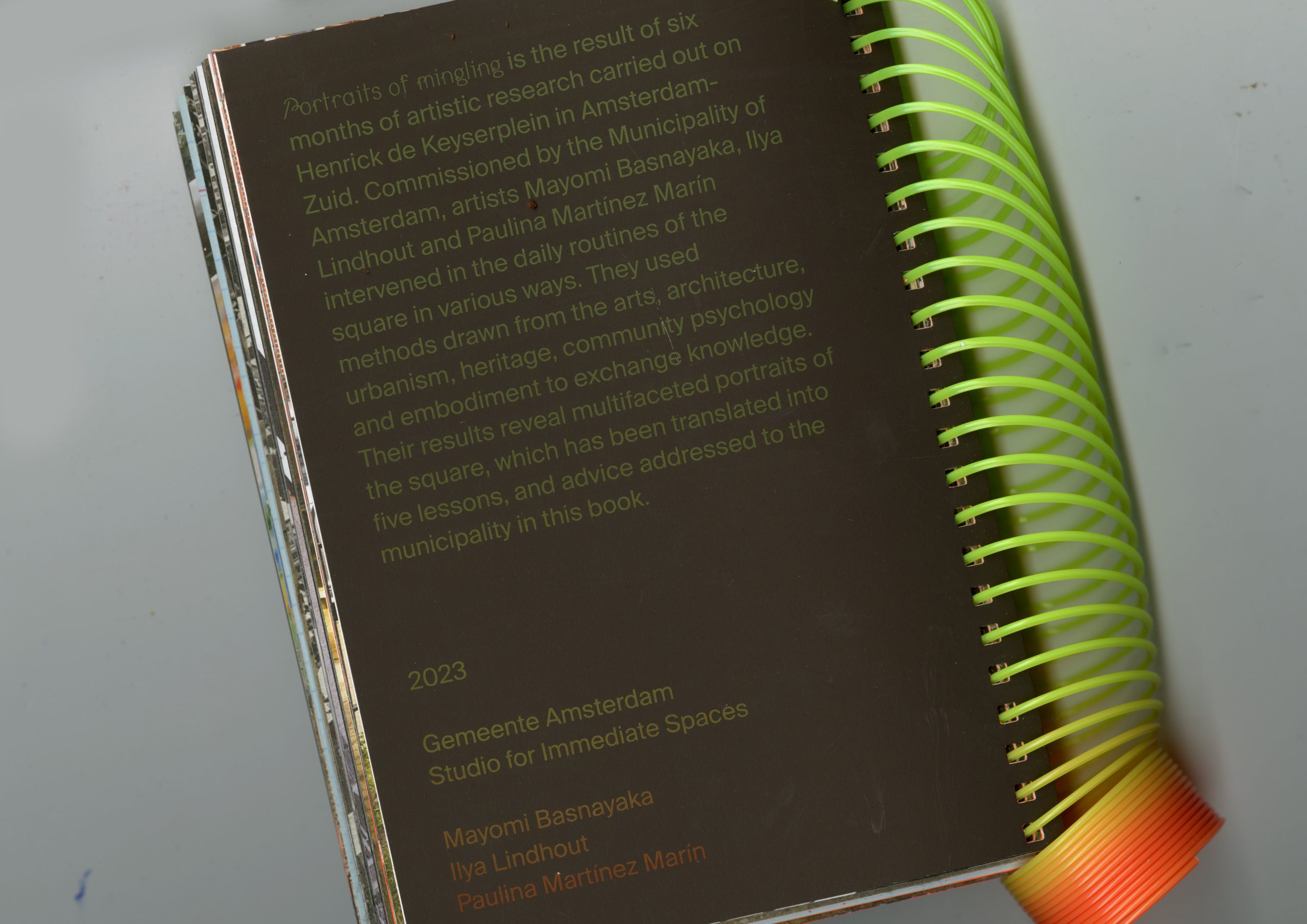
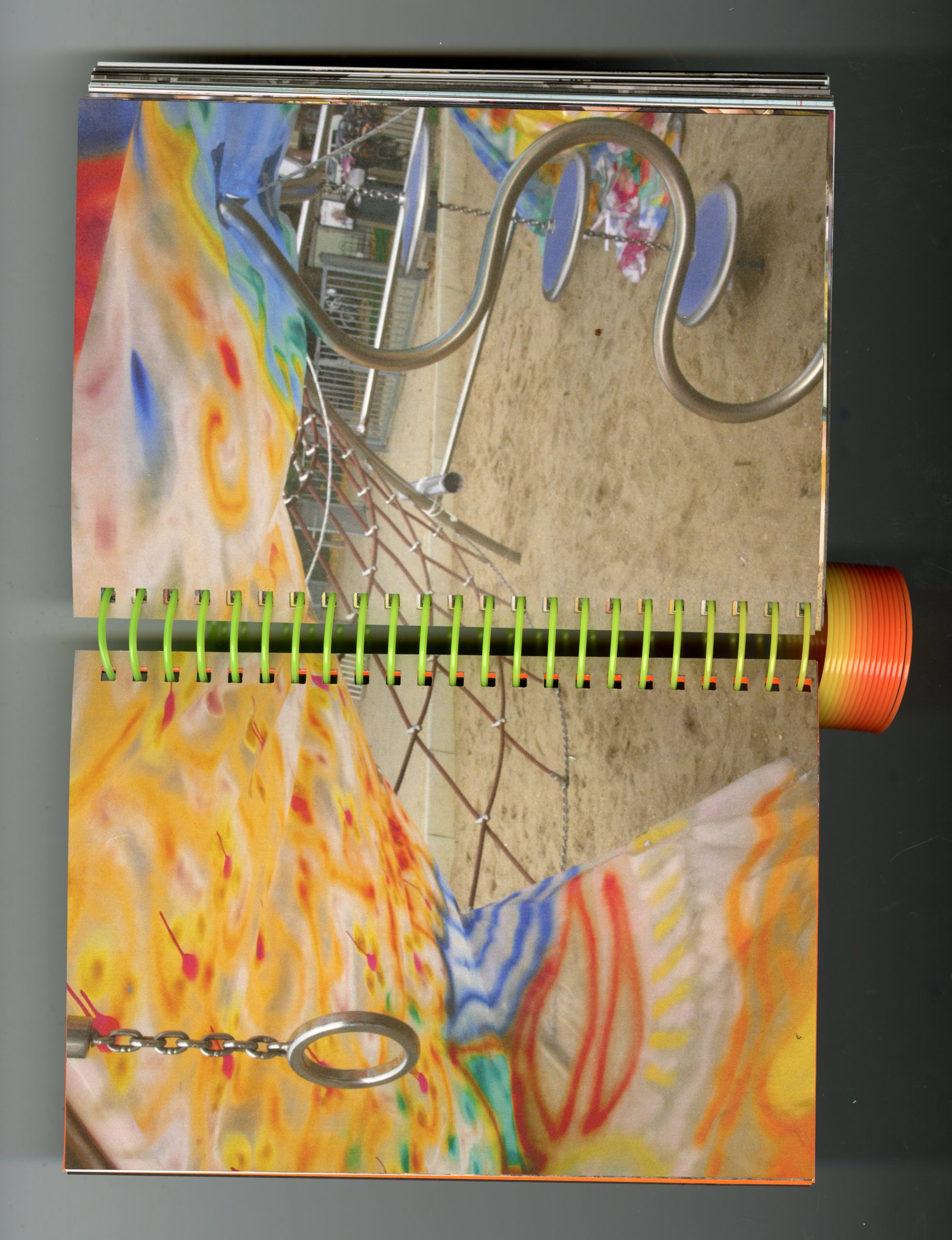
Portraits of Mingling
2023
Henrick de Keyserplein, Amsterdam Stadsdeel Zuid, NL
Portraits of Mingling, Henrick de Keyserplein, Amsterdam, NL
2022-2023
Artistic Research
Public interventions
Publication
Commissioned by the Municipality of Amsterdam, Stadsdeel Zuid
in collaboration with Mayomi Basnayaka and Paulina Martínez Marín, Lectorate Art & Spatial Praxis (LASP) and Rietveld Sandberg Research
Since May 2018, the Municipality of Amsterdam has been working with several organisations, residents and professionals on the development of Henrick de Keyserplein in Amsterdam Stadsdeel Zuid: a big playground used by many ages. Their aim is to reinforce the social structure of the square involving the neighbourhood and all the professional parties that play a role in or around the square.
During the months of October 2022 to March 2023, the transdisciplinary collective carried out site-specific and artistic research at Henrick de Keyserplein, in strong collaboration with its users. To respond to the municipality’s aim, the collective questioned what ‘mingling’ means and entails. They did so by engaging with and inserting themselves into the daily rhythms and livelihoods of the area and the community, learning and exchanging local knowledges. Collective experiences and information were collected and produced through different test interventions using their ‘spiral method’ – just as in a spiral each coil leads to another, each intervention they led informed the next. The method spirals through visiting, interacting, collecting and reflecting. Five test interventions resulted in portraits that demonstrate multiple knowledge, connections and lessons, presented in this publication as an advisory gesture and development strategy towards the Municipality of Amsterdam.
view full publication here
2022-2023
Artistic Research
Public interventions
Publication
Commissioned by the Municipality of Amsterdam, Stadsdeel Zuid
in collaboration with Mayomi Basnayaka and Paulina Martínez Marín, Lectorate Art & Spatial Praxis (LASP) and Rietveld Sandberg Research
Since May 2018, the Municipality of Amsterdam has been working with several organisations, residents and professionals on the development of Henrick de Keyserplein in Amsterdam Stadsdeel Zuid: a big playground used by many ages. Their aim is to reinforce the social structure of the square involving the neighbourhood and all the professional parties that play a role in or around the square.
During the months of October 2022 to March 2023, the transdisciplinary collective carried out site-specific and artistic research at Henrick de Keyserplein, in strong collaboration with its users. To respond to the municipality’s aim, the collective questioned what ‘mingling’ means and entails. They did so by engaging with and inserting themselves into the daily rhythms and livelihoods of the area and the community, learning and exchanging local knowledges. Collective experiences and information were collected and produced through different test interventions using their ‘spiral method’ – just as in a spiral each coil leads to another, each intervention they led informed the next. The method spirals through visiting, interacting, collecting and reflecting. Five test interventions resulted in portraits that demonstrate multiple knowledge, connections and lessons, presented in this publication as an advisory gesture and development strategy towards the Municipality of Amsterdam.
view full publication here


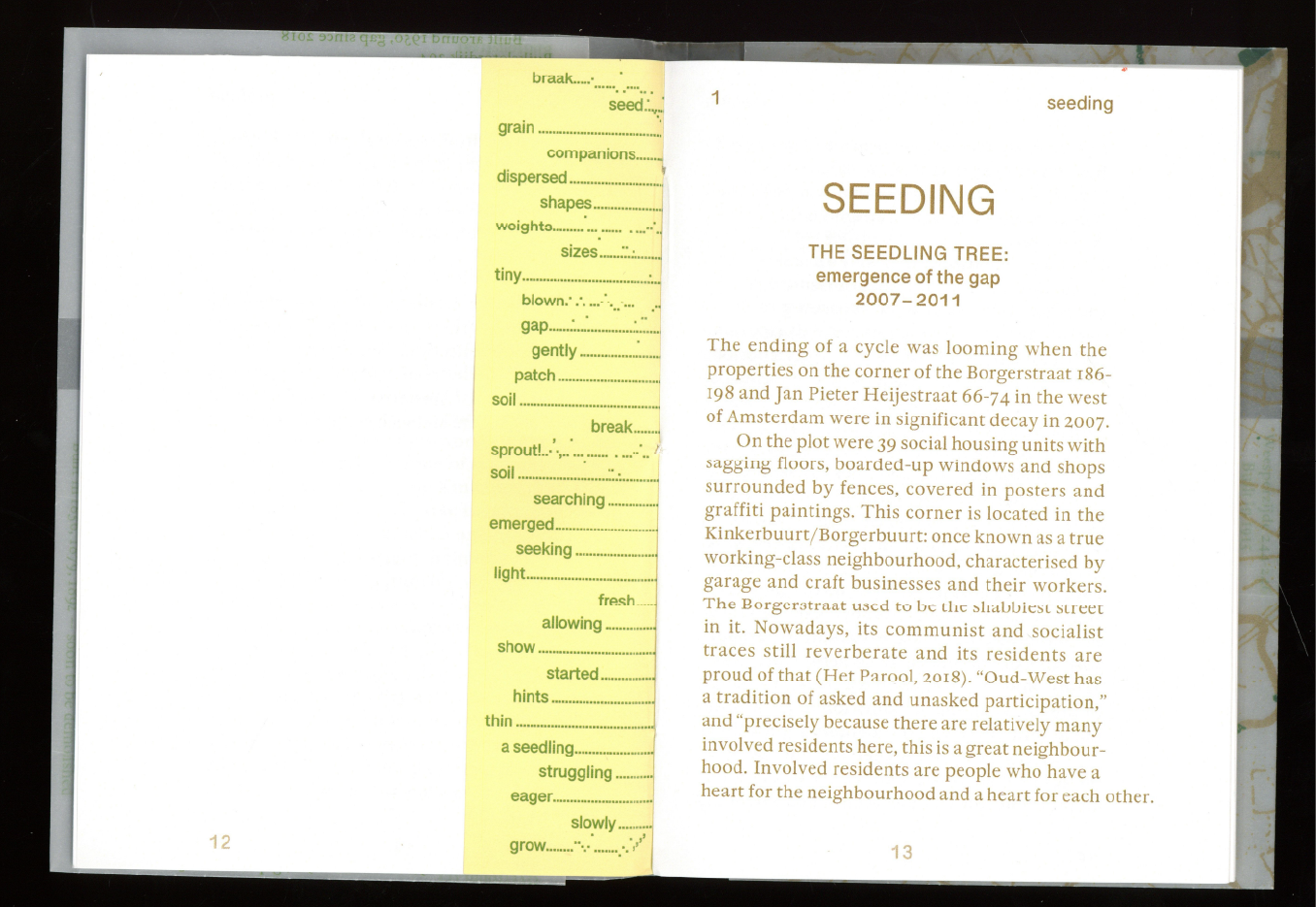

Mind the Gap
2023
Amsterdam, Netherlands
Mind the Gap, 2023
Master thesis Studio for Immediate Spaces, Sandberg Instituut
15 x 10,5 cm
This thesis - consisting of texts, a map, and seeds - explores the values of ‘gaps’ in the urban fabric of Amsterdam: demolished buildings that leave a temporary residual space behind. It investigates how these spaces, which are often overlooked in traditional urban planning approaches, can be valued beyond economic and commercial gain and how they relate to the city’s collective memory. Using the life cycle of a tree as a metaphor and active agent in urban development, the research documents various stages in time, its power dynamics and interests of a specific gap in Amsterdam-West. Questioning who holds power to decide what should be preserved or not and how that impacts the development of the city. The aim of the publication is to embrace the complexity of the in-betweenness as a possibility to counteract, inviting the reader to zoom in on the cracks of their city.
(graphic design by Cathy Hu)
presented at:
2024 Voids (Marken), The Locus with Jonathan Castro, LYL Radio, FR
2023 Bring Your Own Book Fair, ENTER ENTER, Amsterdam, NL
2023 Bring Your Own Book Fair, Rietveld Pavilion, Amsterdam, NL
2023 SISSS Publishing Event, San Serriffe, Amsterdam, NL
Master thesis Studio for Immediate Spaces, Sandberg Instituut
15 x 10,5 cm
This thesis - consisting of texts, a map, and seeds - explores the values of ‘gaps’ in the urban fabric of Amsterdam: demolished buildings that leave a temporary residual space behind. It investigates how these spaces, which are often overlooked in traditional urban planning approaches, can be valued beyond economic and commercial gain and how they relate to the city’s collective memory. Using the life cycle of a tree as a metaphor and active agent in urban development, the research documents various stages in time, its power dynamics and interests of a specific gap in Amsterdam-West. Questioning who holds power to decide what should be preserved or not and how that impacts the development of the city. The aim of the publication is to embrace the complexity of the in-betweenness as a possibility to counteract, inviting the reader to zoom in on the cracks of their city.
(graphic design by Cathy Hu)
presented at:
2024 Voids (Marken), The Locus with Jonathan Castro, LYL Radio, FR
2023 Bring Your Own Book Fair, ENTER ENTER, Amsterdam, NL
2023 Bring Your Own Book Fair, Rietveld Pavilion, Amsterdam, NL
2023 SISSS Publishing Event, San Serriffe, Amsterdam, NL





Air Out The Dirty Laundry
2022
Air Out The Dirty Laundry, 2022
Studio for Immediate Spaces, The Clean Brothers Wasserette, Amsterdam NL
two-day performance
3x2 cm golden raffles
publication
in collaboration with Mayomi Basnayaka and Paulina Martínez Marín
The Clean Brothers Wasserette has been providing its service as a coin-laundry to the Jordaan for more than thirty years, up until now. In a time where each household is expected to be equipped with its own washing machine and dryer, such laundrettes appear as a thing of the past. Nevertheless they are part of a long history: from washing side by side at rivers to sheltered washing places to the big public washhouses in the cities of the industrial age. Throughout history, washing has been a communal activity, primarily carried out by women. The spaces where people would gather to wash thus also informed the communities around it—the exchange of information and the cultivation of connections was an intrinsic part of this ritual.
By encountering the space as an oral and embodied archive, Mayomi Basnayaka, Ilya Lindhout and Paulina Martínez Marín mirrored the knowledge that has been passed on from woman to woman while doing the laundry over the years. Through a layered two—day performance, they shed light on the economy of domestic labour, care and address the intersections between private and public. A resulting publication documents their research and conversations with Annie, the last woman working at the laundromat.
(stills from video documentation by Kyulim Kim)
Studio for Immediate Spaces, The Clean Brothers Wasserette, Amsterdam NL
two-day performance
3x2 cm golden raffles
publication
in collaboration with Mayomi Basnayaka and Paulina Martínez Marín
The Clean Brothers Wasserette has been providing its service as a coin-laundry to the Jordaan for more than thirty years, up until now. In a time where each household is expected to be equipped with its own washing machine and dryer, such laundrettes appear as a thing of the past. Nevertheless they are part of a long history: from washing side by side at rivers to sheltered washing places to the big public washhouses in the cities of the industrial age. Throughout history, washing has been a communal activity, primarily carried out by women. The spaces where people would gather to wash thus also informed the communities around it—the exchange of information and the cultivation of connections was an intrinsic part of this ritual.
By encountering the space as an oral and embodied archive, Mayomi Basnayaka, Ilya Lindhout and Paulina Martínez Marín mirrored the knowledge that has been passed on from woman to woman while doing the laundry over the years. Through a layered two—day performance, they shed light on the economy of domestic labour, care and address the intersections between private and public. A resulting publication documents their research and conversations with Annie, the last woman working at the laundromat.
(stills from video documentation by Kyulim Kim)

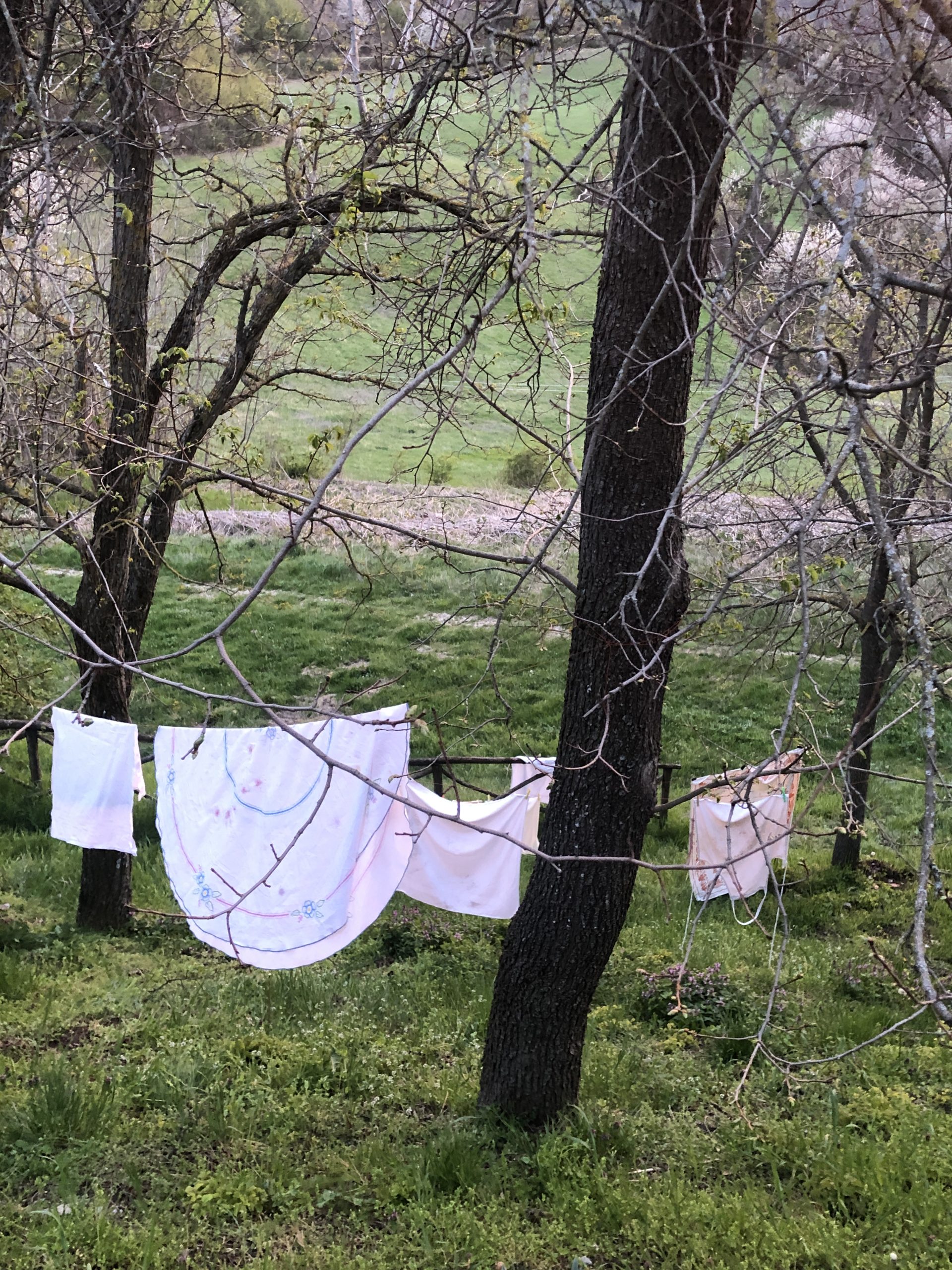
setting up the scenography

collective narration
Ceremony: Hear The Wind Sing
2022
Habitat, Cà de Monti, Tredozio, IT
Ceremony: Hear The Wind Sing, 2022
collective screening, reading, soundscape
Habitat, Cà de Monti, Tredozio, IT
Ceremony (place, date, time) is a platform formed by Pam Virada, Natasha Linde Krebs, and Ilya Lindhout, facilitating shared spaces for collective imagination and reimagination in cinema. We explore how we can experience togetherness in the presence of the moving image by questioning the fundamentals of cinema: how do we sit? Where should the cinema be? How do we arrive to the cinema? We host displaced film screenings that connect films to their surroundings through ritual and scenography - extending the cinematic landscape beyond the screen into the situation.
During our residency time at Habitat, we screened videos compiled from wind memories from participants of Studio for Immediate Spaces in the forest on the hill.

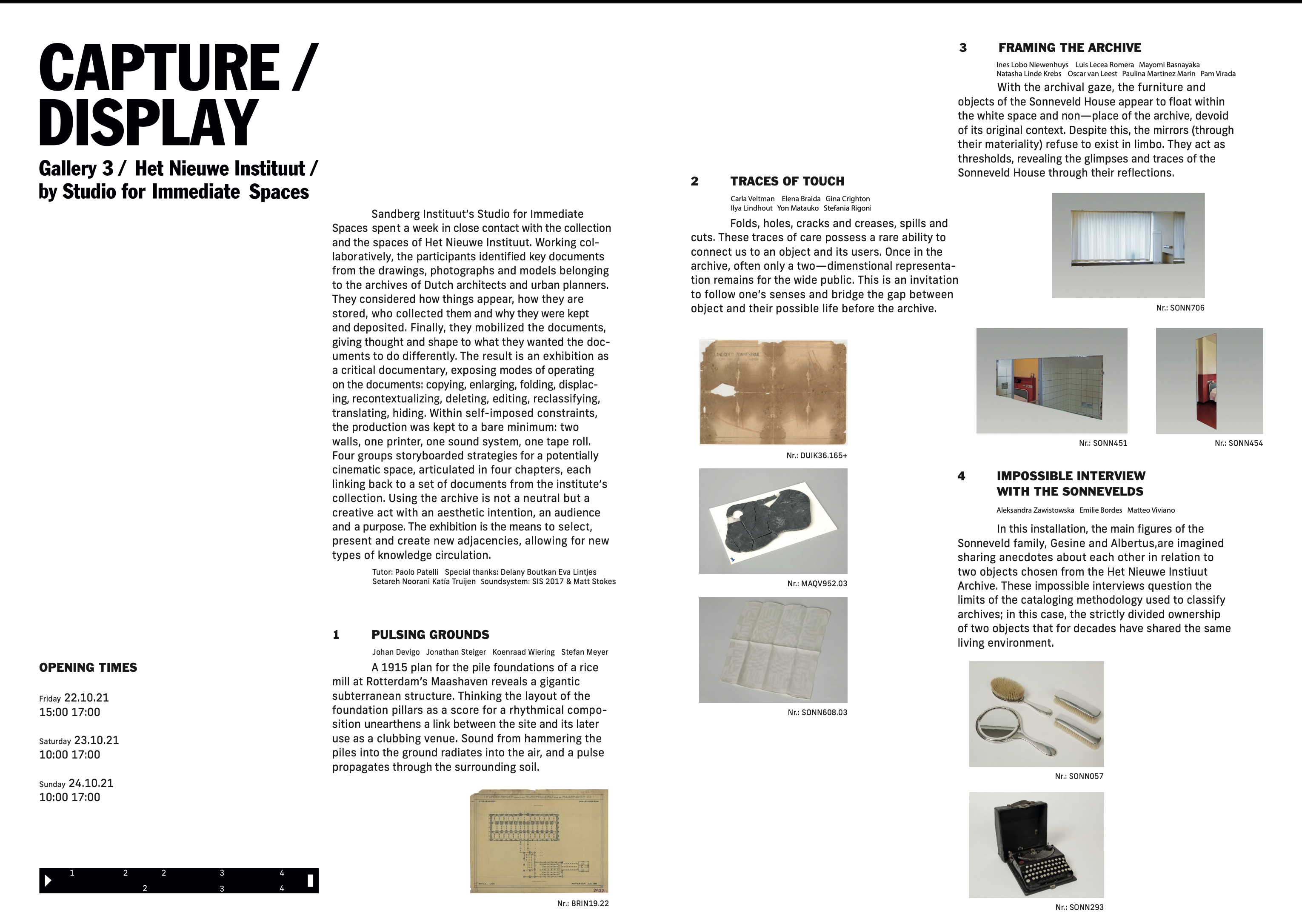

SONN416.03, Vingerdoekje 'Visschen' (Model 561), linnen
Traces of Touch
2021
Gallery 3, Het Nieuwe Instituut, Rotterdam, NL
Traces of Touch, 2021
installation view 'Capture / Display', Gallery 3, Het Nieuwe Instituut, Rotterdam, NL
A4 prints on paper
sound installation
Folds, holes, cracks and creases, spills and cuts. These traces of care possess a rare ability to connect us to an object and its users. Once in the archive, often only a two-dimensional representation remains for the wide public. This is an invitation to follow one’s senses and bridge the gap between object and their possible life before the archive.
The aim of Capture / Display was to produce a pop-up exhibition as a critical documentary, exposing modes of operating on the collection works — copying, enlarging, displacing, recontextualising, deleting, editing, reclassifying, translating, publishing, displaying, hiding and embedding them. Working collaboratively, the participating artists identified key documents from the drawings, photographs and models belonging to the archives of Dutch architects and urban planners. They considered how things appear, how they are stored, who collected them and why they were kept and deposited. Finally, they mobilized the documents, giving thought and shape to what they wanted the documents to do differently.
Using the archive is not a neutral but a creative act with an aesthetic intention, an audience and a purpose. The exhibition is the means to select, present and create new adjacencies, allowing for new types of knowledge circulation.
(in collaboration with Juri Velt, Elena Braida, Gina Crighton, Yon Matauko, Stefania Rigoni)
(types)
- A artistic research
- C commission
- I installation
- M map
- P performance
- P photography
- P print
- R residency
- S screening
- S sound
- T text
- W workshop